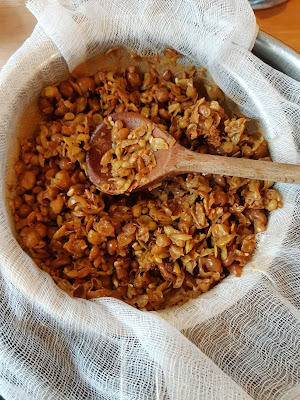After destemming, which took many hours, we tried various ways to mash the grapes. I started with the stainless steel Moulin on the white grapes. It was hard work.
We tried the potato masher but that didn't work very well at all. Alex tried the potato ricer but that was too hard and didn't really work. Then Alex found the insert with bigger holes for the Moulin and that worked pretty well for mashing the 16L of red grapes. It didn't take him that long but I would not have been strong enough to get through that volume. Even with the small quantity, my arms and back are quite sore today. It was quite awkward.
We measured the specific gravity which read exactly 1.060 on the hygrometer. With that reading, we should be adding some sugar. But we didn't last year and our fermentation went well.
We decided not to use Campden (sodium metabisulphite) tablets so we were able to proceed to adding yeast and beginning the fermentation. Alex has a strong dislike of sulphites, which Campden tablets release. You do that to kill bacteria that can ruin your wine. But then you have to wait 24 hours to add yeast or the yeast will die.
So this year, I dissolved one tablespoon of caster sugar in warm water, then let it cool. I added three teaspoons of yeast and covered the jar. That was for the red wine. I did the same with just 1 teaspoon of yeast for the white wine. After about half an hour, with the yeast almost bubbling out of the cup, Alex mixed the yeast into the must. Now we wait 6 days for the primary fermentation. Each day, we stir the must to ensure that the grapes, which float to the top, stay immersed in the must.
The crusher/destemmer we are looking at is the SS model made in Italy by Polsinelli. We'll order it in the Spring so we allow enough time for delivery.
In Sonoma, vintners are testing a new method of destemming and juicing on-site in the vineyard. We aint there yet.
I just ordered a dessert grape called Vanessa for the polytunnel. It's a most unusual colour and almost seedless.



















